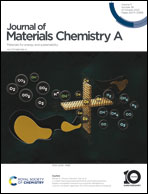Ti3C2Tx and copper sulfide composite nanofluids with a hierarchical structure for sustainable and efficient solar light–thermal conversion†
Abstract
In recent years, solar energy has gained significant attention due to its clean, abundant, and renewable characteristics. Among various solar energy applications, solar thermal conversion has emerged as one of the most promising and straightforward methods. As a new type of photothermal material, MXene has been widely studied, but its low layer roughness and high reflection coefficient result in weak light–thermal conversion performance. In this work, we prepared nanofluids (hereafter named “Ti3C2Tx/FCuS-IL” and “Ti3C2Tx/HCuS-IL”) for light–thermal conversion by utilizing electrostatic interactions between polydopamine modified Ti3C2Tx and CuS composite photothermal materials (Ti3C2Tx/FCuS and Ti3C2Tx/HCuS) with [EBIM]NTf2. The introduction of floral and hollow CuS can effectively increase the surface roughness of Ti3C2Tx, thereby increasing the light receiving area of the material. Research has demonstrated that ionic liquids (ILs) can serve as effective heat collecting working fluids, expanding the liquid path range of nanofluids and providing them with enhanced thermal stability. Furthermore, ILs exhibit lower viscosity, which is advantageous for their efficient pumping in various industrial applications. Research on the light absorption performance and light–thermal conversion performance has found that the Ti3C2Tx/FCuS-IL and Ti3C2Tx/HCuS-IL nanofluids could achieve complete spectral absorption at lower mass fractions of 0.08% and 0.10%, respectively, and exhibited a faster heat transfer rate. The equilibrium temperature (Teq) that Ti3C2Tx/FCuS-IL (0.08%) could achieve was 80.2 °C at 1 sun, with a light–thermal conversion efficiency (ηLTC) of up to 94% and good cycling stability. Additionally, the evaporation performance of Ti3C2Tx/FCuS-IL (0.12%) and Ti3C2Tx/HCuS-IL (0.12%) had been improved by 148.6% and 134.3% compared to pure water at 1 sun. The outstanding light–thermal conversion performance of these nanofluids holds great potential advantages in various applications, such as seawater desalination, cancer treatment, hydrophobic anti-icing, and more.



 Please wait while we load your content...
Please wait while we load your content...